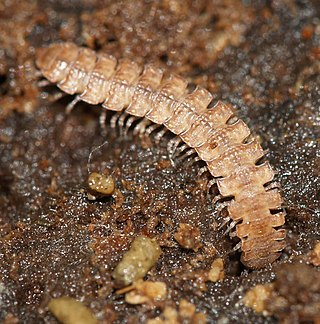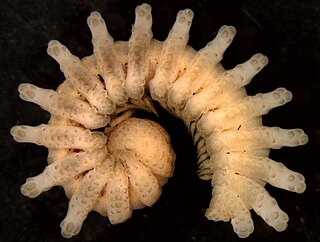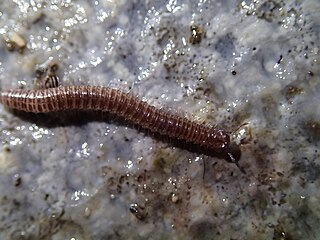
Chilognatha is a subclass of the class Diplopoda, which includes the vast majority of extant millipedes, about 12,000 species.

Glomerida is an order of pill-millipedes found primarily in the Northern Hemisphere. They superficially resemble pill-bugs or woodlice, and can enroll into a protective ball. They have twelve body segments, 17 to 19 pairs of legs, and males have enlarged rear legs involved in mating. The order includes about 30 genera and at least 280 species, including Glomeris marginata, the common European pill-millipede. The order contains members in Europe, South-east Asia and the Americas from California to Guatemala. Although historically considered closely related with the similar sphaerotheriidans that also enroll, some DNA evidence suggest they may be more closely related to glomeridesmidans, a poorly known order that does not enroll.

Polydesmida is the largest order of millipedes, containing approximately 3,500 species, including all the millipedes reported to produce hydrogen cyanide (HCN).

Eutrichodesmus is a genus of millipedes in the family Haplodesmidae, containing at least 32 species in China, Taiwan, and Southeast Asia. One of these species exhibits sexual dimorphism in segments number: The adult females have 20 segments, but the adult males have only 19.

Julidae is a family of millipedes in the order Julida, containing more than 600 species in around 20 genera. Its members are largely confined to the Western Palaearctic, with only a few species extending into the Oriental and Afrotropical realms. They are united by a characteristic form of the mouthparts, and are classified in the superfamily Juloidea of the order Julida, alongside the families Trichoblaniulidae, Rhopaloiulidae and Trichonemasomatidae.

Orthomorpha is a genus of millipedes in the family Paradoxosomatidae containing approximately 50 species distributed in Southeast Asia.

Chordeumatida is a large order of millipedes containing some 1200 species with a nearly worldwide distribution. Also known as "sausage millipedes," they possess around 30 body segments behind the head as adults and reach about 25 mm (0.98 in) in length.
Siphonophoridae is a family of millipede in the order Siphonophorida. There are about 12 genera and more than 110 described species in Siphonophoridae.

Andrognathidae is a family of millipede in the order Platydesmida. There are about 17 genera and more than 30 described species in Andrognathidae.

Haplodesmidae is a family of millipedes in the order Polydesmida. Species occur in East Asia, Southeast Asia, and Oceania, although some species have been introduced to the New world tropics. Species are small bodied, often with elaborate sculpturing on the tergites, and some species are capable of rolling into a near-complete ball.

Ammodesmidae is a family of small millipedes endemic to Africa, containing seven species in two genera. Ammodesmids range from 1.4 to 5.0 mm long with 18 or 19 body segments in both sexes, and are capable of rolling into a tight sphere.

Anoplodesmus is a genus of millipedes. It is one of the most species rich genera in the family Paradoxosomatidae, with over 40 described species distributed from India and Nepal to China and Southeast Asia, as well as the Mascarene Islands and Fiji.

Anthroleucosomatidae is a family of millipedes in the order Chordeumatida. These millipedes range from 3.5 mm to 28 mm in length. Adult millipedes in this family have 26, 28, 30, or 31 segments. This family includes Metamastigophorophyllon martensi, notable as the only chordeumatidan species with 31 segments. There are about 38 genera in Anthroleucosomatidae.

Anamastigona is a genus of millipedes in the family Anthroleucosomatidae. There are about 20 described species in Anamastigona, found mainly in Europe and the Middle East.

Ophyiulus is a genus of millipedes in the family Julidae. There are more than 30 described species in Ophyiulus.

Metopidiotrichidae is a family of millipedes in the order Chordeumatida. These millipedes range from 4 mm to 17 mm in length. Adult millipedes in this family have 32 segments, not the 30 segments usually found in this order. Adult males in this family often feature a reduced or vestigial leg pair 10 as part of the gonopod complex, in addition to the two leg pairs typically modified into gonopods in this order. There are about 9 genera and at least 70 described species in Metopidiotrichidae.
Diplomaragnidae is a family of millipedes belonging to the order Chordeumatida. These millipedes range from 9 mm to 24 mm in length and are found from the Volga River region in Russia to Japan and Taiwan. Adult females in this family have 32 segments rather than the 30 segments typically found in this order, while adult males have either 30 or 32 segments.
Trachygonidae is a family of millipedes belonging to the order Chordeumatida. Adult millipedes in this family have 28 or 30 segments.
Heterolatzeliidae is a family of millipedes belonging to the order Chordeumatida. Adult millipedes in this family have 30 segments.
Opisthocheiridae is a family of millipedes belonging to the order Chordeumatida. These millipedes range from 5 mm to 16 mm in length and are found from Belgium to Morocco. Adult millipedes in this family have 26 or 30 segments. This family includes the species Opisthocheiron canayerensis, one of the few species in this order with only 26 segments.












